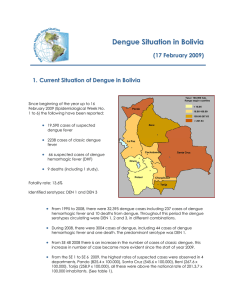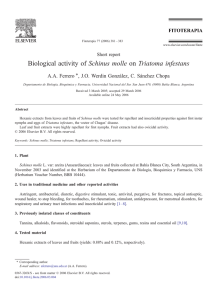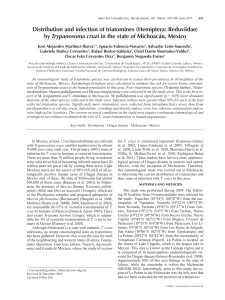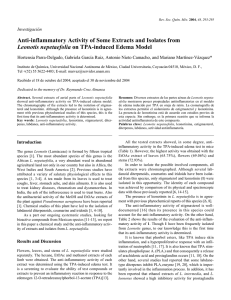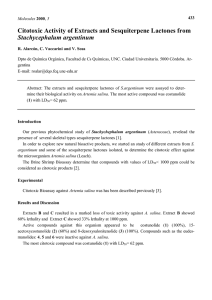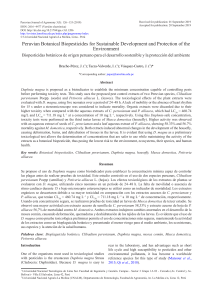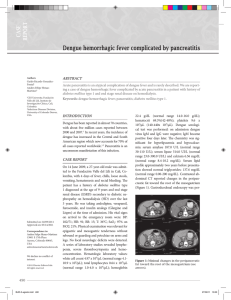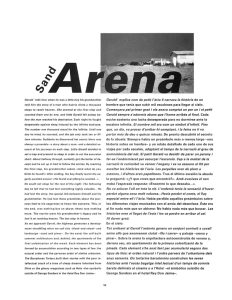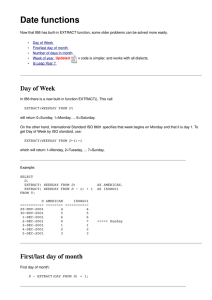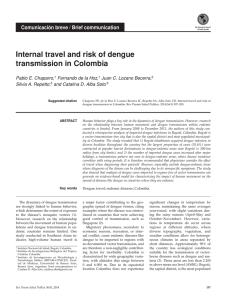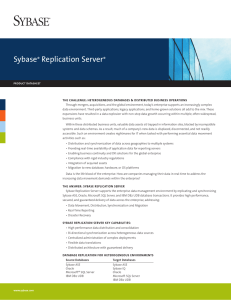CIENCIA COMPLETA-2.vp - Universidad del Zulia
Anuncio
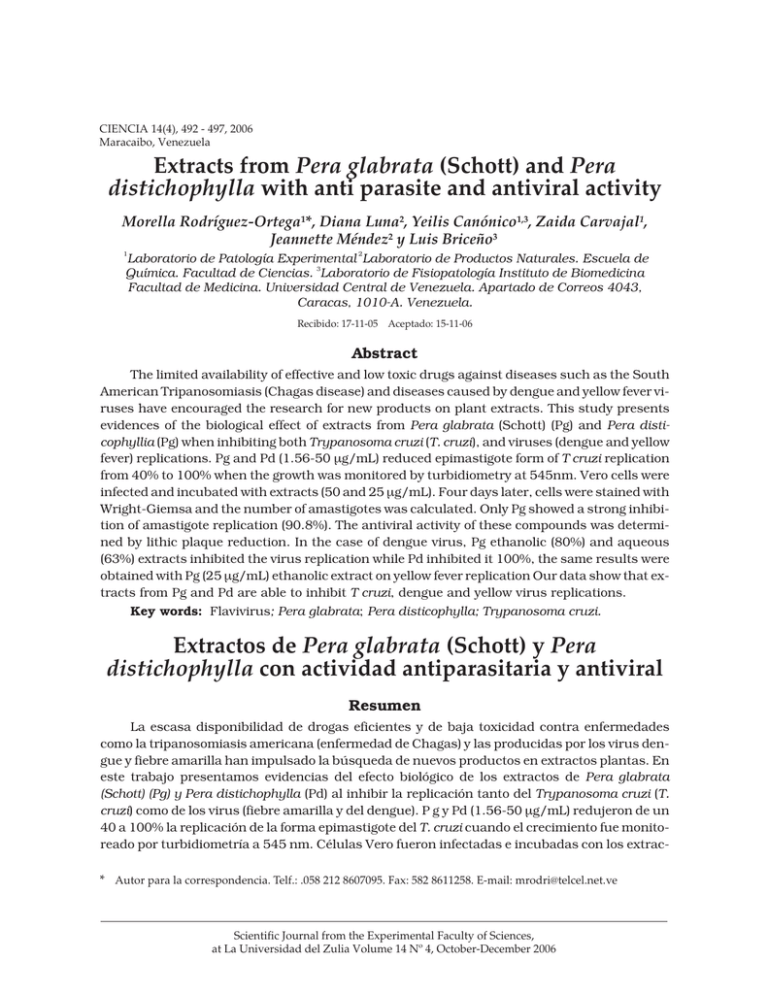
CIENCIA 14(4), 492 - 497, 2006 Maracaibo, Venezuela Extracts from Pera glabrata (Schott) and Pera distichophylla with anti parasite and antiviral activity Morella Rodríguez-Ortega1*, Diana Luna2, Yeilis Canónico1,3, Zaida Carvajal1, Jeannette Méndez2 y Luis Briceño3 1 Laboratorio de Patología Experimental 2Laboratorio de Productos Naturales. Escuela de Química. Facultad de Ciencias. 3Laboratorio de Fisiopatología Instituto de Biomedicina Facultad de Medicina. Universidad Central de Venezuela. Apartado de Correos 4043, Caracas, 1010-A. Venezuela. Recibido: 17-11-05 Aceptado: 15-11-06 Abstract The limited availability of effective and low toxic drugs against diseases such as the South American Tripanosomiasis (Chagas disease) and diseases caused by dengue and yellow fever viruses have encouraged the research for new products on plant extracts. This study presents evidences of the biological effect of extracts from Pera glabrata (Schott) (Pg) and Pera disticophyllia (Pg) when inhibiting both Trypanosoma cruzi (T. cruzi), and viruses (dengue and yellow fever) replications. Pg and Pd (1.56-50 µg/mL) reduced epimastigote form of T cruzi replication from 40% to 100% when the growth was monitored by turbidiometry at 545nm. Vero cells were infected and incubated with extracts (50 and 25 µg/mL). Four days later, cells were stained with Wright-Giemsa and the number of amastigotes was calculated. Only Pg showed a strong inhibition of amastigote replication (90.8%). The antiviral activity of these compounds was determined by lithic plaque reduction. In the case of dengue virus, Pg ethanolic (80%) and aqueous (63%) extracts inhibited the virus replication while Pd inhibited it 100%, the same results were obtained with Pg (25 µg/mL) ethanolic extract on yellow fever replication Our data show that extracts from Pg and Pd are able to inhibit T cruzi, dengue and yellow virus replications. Key words: Flavivirus; Pera glabrata; Pera disticophylla; Trypanosoma cruzi. Extractos de Pera glabrata (Schott) y Pera distichophylla con actividad antiparasitaria y antiviral Resumen La escasa disponibilidad de drogas eficientes y de baja toxicidad contra enfermedades como la tripanosomiasis americana (enfermedad de Chagas) y las producidas por los virus dengue y fiebre amarilla han impulsado la búsqueda de nuevos productos en extractos plantas. En este trabajo presentamos evidencias del efecto biológico de los extractos de Pera glabrata (Schott) (Pg) y Pera distichophylla (Pd) al inhibir la replicación tanto del Trypanosoma cruzi (T. cruzi) como de los virus (fiebre amarilla y del dengue). P g y Pd (1.56-50 µg/mL) redujeron de un 40 a 100% la replicación de la forma epimastigote del T. cruzi cuando el crecimiento fue monitoreado por turbidiometría a 545 nm. Células Vero fueron infectadas e incubadas con los extrac* Autor para la correspondencia. Telf.: .058 212 8607095. Fax: 582 8611258. E-mail: [email protected] Scientific Journal from the Experimental Faculty of Sciences, at La Universidad del Zulia Volume 14 Nº 4, October-December 2006 M. Rodríguez Ortega y et al. / Ciencia Vol. 14, Nº 4 (2006) 492 - 497 493 tos (50-25 µg/mL). Después de cuatro días las células fueron teñidas con Wright-Giemsa y el número de amastigotes fue determinado. Solo Pg mostró una fuerte inhibición de la replicación de los amastigotes (90,8%). La actividad antiviral de estos compuestos fue determinada por reducción de placas líticas En el caso de Virus del dengue, el extracto etanolico (80%) y el acuoso (63%) de Pg, inhiben la replicación, mientras que Pd, la inhibe en un 100 %. Similares. Resultados fueron obtenidos con el extracto etanolico de Pg (25 µg/mL) sobre la replicación del virus de la fiebre amarilla. Nuestros datos demuestran que los extractos de Pg y Pd son capaces de inhibir la replicación del T. cruzi y de los virus dengue y fiebre amarilla. Palabras clave: Flavivirus; Pera glabrata; Pera distichophylla; Tripanosoma cruzi. Introduction Chagas disease is a public health problem in many Latin American countries. It is treated with drugs that often present severe side effects (1) and are usually effective during the acute phase of the disease but not in the chronic phase (2). In many cases the drugs employed for treatment are toxic, marginally effective and are compromised by the development of resistance (3). The genus flavivirus comprises over 70 viruses, many of which are associated with human diseases. The mosquito-borne such as dengue, yellow fever and West Nile are viruses especially important for public health (4). Despite the major clinical impact of dengue and yellow fever viruses, there is not yet a drug available for chemoprophylaxis or chemotherapy against diseases produced by these viruses (5). Plant extracts provide unlimited opportunities for a new drug leads because of the unmatched availability of chemical diversity. Species from the Euphorbiaceae family have been studied for their efficacy against some parasites and viruses (6, 7). There are 30 known species of this genus, nine of them can be found in Venezuela (8), including Pera glabrata (Schott) and Pera distichophylla. A member of this family, Pera benensis, is used as a treatment of cutaneous leishmaniasis, by Bolivian Indians (8). Quinones have been the most common compound encountered for the biological activity of this genus (9, 10). Researching for a novel lead compounds against infectious pathogens as the parasite T. cruzi, and viruses belonging to the Flaviviridae family, we have tested the effect of Pera glabrata and disticophylla extracts on their replication. Experimental Part Plant material Leaves of Pera glabrata were collected in the Henry Pittier National Park in Maracay, Estado Aragua, Venezuela and identified by Dr. Baltazar Trujillo Figueroa. A voucher specimen (number 309759) was deposited in the herbarium of the Facultad de Agronomía, Universidad Central de Venezuela, Maracay, Estado Aragua. Leaves of Pera distichophylla were identified and collected by Prof. Anibal Castillo. A voucher specimen (number 6836) was deposited in the national herbarium at the Caracas Botanic Garden, Caracas, Venezuela. Extraction and isolation Powdered dried leaves of Pera glabrata (595.0 gr.) and Pera distichophylla (788.0 gr.) were defatted in a Soxhlet apparatus with n-hexane and then extracted with MeOH for three days. This extract was partitioned with BuOH/H2O (1:1) yielding for Pera glabrata Ec (2.3 gr., alcoholic extract) and Ea (3.0 gr., aqueous extract) and from Pera distichophylla Ec. (5,11 gr. alcoholic extract) and Ea (3.0 gr., aqueous extract). Stock solutions (1 mg/mL) for biological assays were prepared Scientific Journal from the Experimental Faculty of Sciences, at La Universidad del Zulia Volume 14 Nº 4, October-December 2006 494 Extracts from Pera glabrata (schott) and Pera distichophylla by dissolving each extract in Dimethylsulphoxide (0.5%). The final concentration of DMSO was not toxico to the Vero cells (data not shown). Trypanocidal activity Venezuelan strain EP (Elpidio Padrón) was used to determine the effect of the extracts on the growth iof T. cruzi epimastigotas. It was cultured in liver infusion tryptose (LIT) medium supplemented with 10% of heat-inactivated fetal calf serum and seeded in 96 wells plates, at 1 x 105 protozoa/200 L. The different extract concentrations (1.5650 µg/mL) were prepared and added to the wells after the parasite seeding. Ketoconazole (11) was used as a reference drug at the same concentration of the extracts to be tested. The optical density was measured at 0, 48, 96, and 144 hours at 545 nm. The assays were carried out in triplicate and the inhibition of parasite growth was calculated according to the expression reported previously (12). Extract effect on amastigote replication Vero cells were infected with T. cruzi strain Y stock and subcultured every 4 days. Trypomastigotes, the infective form of T. cruzi, were collected and centrifuged at 800g for 10 min at 4°C to remove host cells and debris, the resulting super natant was then centrifuged at 1500g for 10 min. at 4°C and the pellet containing the trypomastigotes was washed three times with Eagles Essential Medium (MEM). The purified trypomastigotes were counted in a Neubauer hemacytome ter. Vero cells (2x104cell/mL) were seeded in BELLCO Chamberslides; after 24h of incubation they were infected with 3 x 105 trypomastigotes in the presence of the extracts (50-25 µg/mL). Four days later, the slides were processed and stained with Wright-Giemsa. The percentage of infected cells and the average number of amastigotes per infected cell were determined microscopically. Two hundred cells were analyzed in each cell culture spot (13). The percentage of infection was determined as follows: % Protection= A-B/A X100, where A is the number of infected cell and B the number of infected cell treated and the percentage of amastigote reduction was calculated as follows: % amastigote reduction: C-D/C x 100. Being C the average number of amastigotes in in fec tion con trol and D de av er age number of amastigotes in treated cell (14). Antiviral Activity Extract effect over the replication of dengue 2 (New Guinea strain obtained from the Center for Disease Control, USA) and yellow fever, viruses (vaccine strain, gift from Dr. Liprandi) on mammalian cells was carried out by a plaque reduction assay (14). Vero cells a final concentration of 2,5 x 105 cell/ml were seeded in 24 wells plate. The infections were done in the presence or absence of extract (25 µg/mL) with a MOI of 0,2 pfu. Plaques were counted four or five days after infection with yellow fever or dengue virus, respectively. All experiments were per formed in triplicate with viral and cells controls, and each experiment was reproduced a minimum of three times. The antiviral activity of the compounds was determined by the plaque reduction as follows: % PR= (Viral Control-Treated Cells)/ Viral Control x100) (15). Data analysis: Statistical studies were carried out using GraphPad InStat 4.0 (GraphPad Software San Diego California U.S.A. http://www.graphpad.com Results and Discussion The extract of Pg and Pd showed a significant activity on epimastigote forms of T. cruzi, being able to reduce the parasite replication from 40 to 100% in the concentration range used, this inhibition is higher than the one obtained with Ketoconazole (Figura 1), which has been reported to display a potent anti T. cruzi effect and drastically reduce the infection rate11. Based on these results we evaluated the effect of this extract on Vero cells and amastigotes replication. Both extracts were not cytotoxic when screened Scientific Journal from the Experimental Faculty of Sciences, at La Universidad del Zulia Volume 14 Nº 4, October-December 2006 M. Rodríguez Ortega y et al. / Ciencia Vol. 14, Nº 4 (2006) 492 - 497 495 Table 1 Effect of Pera glabrata and Pera distichophylla extracts on Trypanosoma cruzi infection on Vero cells Extract Concentrations Pera glabrata Pera distichophylia % Infection Nº Amastigotes/ cell number µg/mL Control Extracts Control Extracts 50 9.5 1.6 0.58±0.16 0.053±0.02* 25 10.25 3.8 0.74±0.15 0.15±0.04* 50 4.8 5.3 0.39±0.11 0.30±0.8 Mean ± SD * Significantly different from control (p<0.05). Therapy against T. cruzi is not satisfactory. The treatment is only ef fective during the acute phase of the disease in some patients but not in all of them. In addition, the drug used has severe side ef fects and drug resistance may develop (18). One approach to search for a more ef fective and safe drug against T. cruzi has been the use of plants (10, 3, 19, 20), algae extract (19) and their components (10, 20). In the present study we demonstrated a strong inhibitory effect of both extracts against epimastigote replication (Figura 1). The fact that Pg extracts was able to reduce the number of amastigotes (Table 2), implying an intracellular growth reduction, together with inhibition on epimastigote replication (vector infective form), indicating the presence in the Pg ex- 100 75 % growth inhibition on the Vero cell line, using a colorimetric method with MTT [3-(4,5- di methyl thia zol- 2- yl) 2,5diphenyl-tetrazolium bromide] (16), after 24 h and 5 days of incubation with 50 µg/mL (data no shown). Pg is able to inhibit the infection of Vero cells by trypanomastigotes on 63% and 84% at 25 and 50 µg/mL, respectively (Table 1). Also Pg extract (50 µg/mL) showed a significant and strong inhibition on amastigote replication, reducing up to 90.8% the number of amastigotes per cell. Pd did not have any effect on infection rate or amastigotes replication (Table 1). The antiparasite activity of Pg has not been limited to any active portion tested until now, it could be that this extract exerts its anti T. cruzi effect by cooperation of different active fractions, as it has been repotted for other plant extracts (17). 50 25 0 1,56 3,13 6,25 12,5 25 50 Extract Concentrations (µg/mL) Figura 1. Growth Inhibition of T. cruzi. epimastigotes form: Parasites Pg (n), Pd (u), Ketoconazol (). Data represent the mean of three independent experiments. tract of compounds with strong inhibitory activity on T. cruzi replication, that may inhibit the parasite entrance to the cell and /or decrease in the transfor mation from trypomastigotes to amastigote. Recently, in screening of Brazilian plants, Pera glabrata did not shown anti-bacterial or anti-fugal ef fect (19). Anti-protozoa activity has been reported for other members of the Euphorbiaceae family (10). But this is the first re- Scientific Journal from the Experimental Faculty of Sciences, at La Universidad del Zulia Volume 14 Nº 4, October-December 2006 496 Extracts from Pera glabrata (schott) and Pera distichophylla Table 2 Inhibition of flavivirus replication by alcoholic and aqueous extracts % of Inhibition Exctracts 25µg/mL Dengue-2 virus Yellow fever virus Pg (Ec) 80 100 Pg (Ea) 62.5 NT Pd (Ec) 100 NT Acknowledgment This study was supported by Grants from CONICIT project N° G-97000627 and FONACIT project G2000001530. References 1. KIRCHOFF L.V. Current Infect Dis Rep 5: 59-63, 2003. 2. URBINA JA., Curr Opin Infect Dis 14: 733-741, 2001. NT no tested, Pg: Pera glabrata Pd: Pera disticophyllia Ec: alcoholic extract, Ea: aqueous extract. 3. SALEM M.M., Werbovetz KA Curr Med Chem 13; 2571-2598, 2006. port of anti-trypanosome activity by Pera glabrata extract. 4. CHIANG-JANG LING CHIANG-LEN LIAO and YI-LING LIN J Virol 70: 8388-8399, 2005. As part of our research on plant metabolites as antiviral agents we tested the different extracts of Pg and Pd (aqueous and alcoholic) against yellow fever and dengue viruses replication. Pg ethanolic and aqueous extracts inhibited dengue virus replication; however, the alcoholic extract was more effective, reducing plaque formation by 80% (Table 2). Pd and Pg inhibited plaque formation by 100% of dengue and yellow fever viruses respectively (Table 2). Our findings open the possibility of isolating and identifying compounds of plants origin that could be potential drugs against T cruzi, dengue and yellow fever viruses. Conclusión The alcoholic extracts from Pg and Pd were able to inhibit the replication of the epimastigote form of T. cruzi. In addition, Pg showed a significant effect on amastigote replication. The alcoholic extracts were more effective againts the virus replication (dengue and yellow fever) than aqueosus one. Of the two alcoholic extracts used in the present studied, Pg shows a significant inhibitory effect in species pathogen as diverse as T. cruzi and viruses like dengue and Yellow fever. 5. LEYSSEN P., DE CLERCQ E., NEYTS J. J Clin Microbiol Rew 13: 67-82, 2000. 6. MACROE MW. HUDSON JB., TOWERS GH. Euphorbiaceae J Ethnophar macol 22: 143-172, 1988. 7. MADUREIRA A.M., ASCENSO J.R., VALDEIRA L., DUARTE A., FRADE J.P., FREITAS G., FERREIRA M. J Nat Prod Res 17: 375-384, 2003. 8. BERRY P., YATSKEVYCH K., HOLST B. Missouri Botanical Garden Press, St. Louis. pp. 228, 1999. 9. CUCAS L.E., MARTÍNEZ J.C., JARAMILLO R. Revista Colombiana de Química. 12: 67-72, 1983. 10. FOURNET A., ANGELO A., MUÑOZ V., ROBLOT F., HOCQUEMILLER R. and CAVÉ A. J Ethnophar macol 37: 159-164, 1992. 11. SILVA D.T., DE NAZ ARETH S.L., DE MEIRELLES M., ALMEIDA D., URBINA JA, PEREIRA MC. Int. J Antimicrob Agents 27: 530-539, 2006. 12. MUELAS- SERRANO S., NOGAL J.J., MAR TÍNEZ- DÍAZ R.A., ES CARIO J.A., MAR TÍNEZ-FERNÁNDEZ A.R., GÓMEZBARRIO A. J Eth no phar macol 71: 101-112, 2000. Scientific Journal from the Experimental Faculty of Sciences, at La Universidad del Zulia Volume 14 Nº 4, October-December 2006 M. Rodríguez Ortega y et al. / Ciencia Vol. 14, Nº 4 (2006) 492 - 497 497 13. MAR TIN A., SAN CHEZ N.L., DIAZ O., ZERPA EMILIA Negron, Jacinto CONVIT and Felix J. Tapia Am. J. Trop. Med Hyg. 70: 618624, 2004. 18. MONTALVETTI A., BAILEY B.N., MAR TIN M.B., SEVERIN G.W., OLDFIELD E., DOCAMPO R. J Biol Chem 276: 33930-33937, 2001. 14. KUROKAWA M., NAGASAKA K., HIRABAYASHI T., UYAMA S., SATO H., KAGEYAMA T., KADOTA S., OHYAMA H., HOZUMI T., NAMBA T., SHI RAKI K. An tivi ral Research 27: 19-25, 1995. 19. MALTA V., PINTO A., MOLFETTA, F., HONÓRICO K., De SIMONE C., PEREIRA M., SANTOS, R. and DA SILVA A. J Molecular Structure 634: 271-282, 2003. 15. PAREDES A. HASEGAWA M., PIETRO F., MENDEZ J., RODRÍGUEZ-ORTEGA M. J Ethnnolphar macol 78: 129-132, 2001. 20. PRYTZYK E, DANTAS AP, SALOMAO K, PEREIRA AS, BANKOVA VS, DE CASTRO SL , NET O F R. J Et h no phar m a c ol 88:189-193, 2003. 16. SHEARMAN M.S., IAN RAGAN C., IVERSEN, L.L., Proc of Nat. Acad of Sci USA, 91: 1470-1482, 1994. 21. GOMES D., LEITE M.E., ROGERIO M., INFANTE C., DA SILVA V., CORDEIRO I., et al. Biotia Neurotop 4: 1-15, 2004. 17. ZHAO Yl., QU F., XIAO XH., WANG JB., MA YG., SUN YQ., CHIN. J Med 12: 42-53, 2006. Scientific Journal from the Experimental Faculty of Sciences, at La Universidad del Zulia Volume 14 Nº 4, October-December 2006
